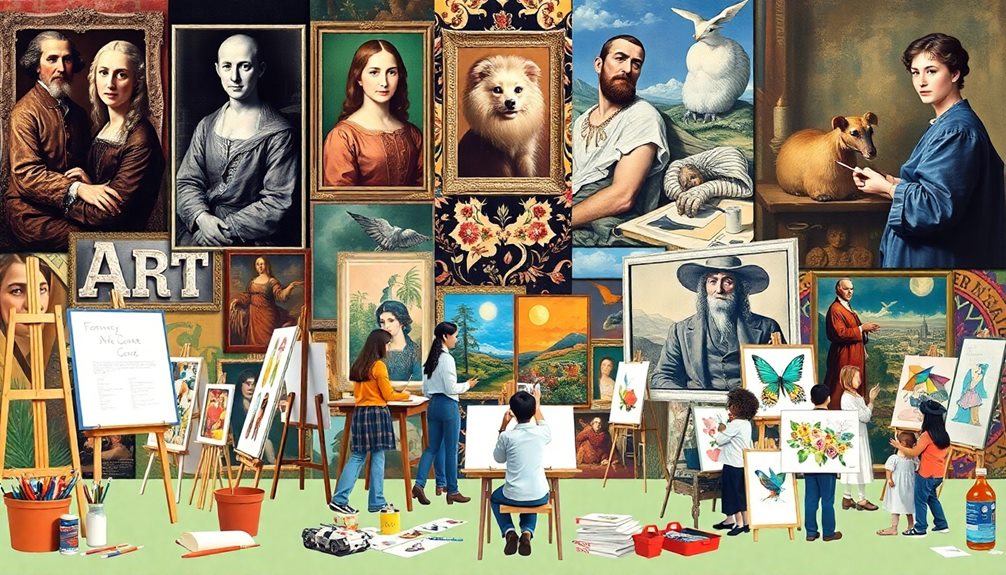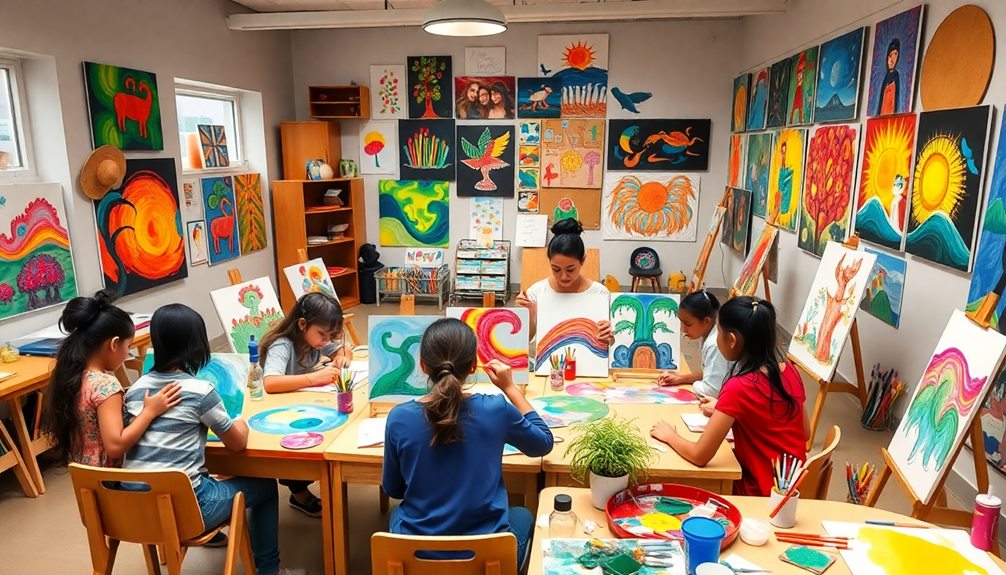With a degree in art education, you've got several rewarding career paths ahead. You can become an art teacher in K-12 schools, inspiring young minds and fueling their creativity. Alternatively, consider roles as a museum educator or an art therapist, both of which combine art with unique learning experiences or healing practices. If curriculum design interests you, plenty of opportunities exist for creating innovative art programs. The job market's vibrant, with a steady growth of 4% projected. Explore how to optimize your career choices and make impactful connections along the way.
Key Takeaways
- Art education degrees offer diverse career paths, including K-12 teaching, museum education, and art therapy, enhancing creativity and community engagement.
- A bachelor's degree in art education is typically required, with many positions promoting ongoing education and professional development for career advancement.
- Job growth in art education is projected at 4% from 2020 to 2030, reflecting a steady demand for skilled professionals in various roles.
- Networking with educators and alumni can create valuable connections, leading to job opportunities and collaborative projects in the field of art education.
- Continuous learning through workshops and professional development is essential for maintaining teaching certification and enhancing instructional effectiveness in art education.
Overview of Art Education Degrees

Art education degrees lay the foundation for a rewarding career in teaching and promoting artistic expression. These programs, including BFA, MFA, MAT, and Ph.D., focus on equipping you with essential skills for teaching art in various educational settings.
You'll immerse yourself in coursework that covers art history, art criticism, pedagogy, and effective teaching methodologies, ensuring you receive a well-rounded education.
Hands-on studio practice is a crucial component of your learning, allowing you to hone your artistic abilities while preparing to share your passion with students. Through student teaching opportunities, you'll gain invaluable practical experience in real classroom environments, which is essential for becoming an effective art educator.
Many degree programs also explore multiculturalism within art contexts, fostering a broader understanding of diverse artistic expressions and histories. This aspect not only enriches your education but also prepares you to engage with a wide range of students and their unique perspectives.
Traditional Career Paths

As you explore traditional career paths in art education, becoming an art teacher in K-12 schools stands out as a popular choice.
This role not only allows you to inspire creativity in students but also offers opportunities to engage in diverse activities like advising art clubs and organizing exhibitions.
With a growing demand for qualified art teachers, now's a great time to contemplate this rewarding career.
Art Teacher Opportunities
Teaching art in K-12 schools offers a fulfilling career path for those passionate about creativity and education. As an art teacher, you'll need a bachelor's degree in art education, and many schools require you to earn a master's degree within five years to maintain your certification.
You'll provide instruction across various media like drawing, painting, ceramics, and photography, nurturing your art education students' artistic skills and creativity.
In addition to teaching, art teachers often engage in curriculum development and lesson planning, integrating art history and criticism into their classes. This approach not only enhances students' understanding of art but also enriches their overall educational experience.
With a median salary of around $60,000 annually, your earnings can increase based on your experience and any advanced degrees you pursue.
The job growth for art teachers is projected at 4% from 2020 to 2030, indicating a steady demand for qualified educators in the arts. This makes a career as an art teacher both rewarding and stable, offering you the chance to inspire the next generation of artists while pursuing your passion.
Diverse Career Options
Beyond K-12 teaching, art education graduates have a wealth of diverse career options to explore. One popular path is becoming a museum educator, where you'll develop public programs and educational content for visitors, enriching their experience outside the traditional classroom.
If you're interested in blending creativity with psychological support, consider a career in art therapy. This fulfilling role requires a master's degree after obtaining your bachelor's in art education, allowing you to help others through the healing power of art.
Another avenue is curriculum design, where you'll work as an instructional coordinator, creating and implementing effective art education programs. This role is essential in shaping educational careers in various settings, with projected job growth of 7% through 2031, making it a stable option for art education graduates.
Each of these career options showcases the versatility of your degree, allowing you to use your passion for art in unique and impactful ways. Whether you decide to teach, design curricula, or investigate art therapy, the possibilities are endless.
Expanding Opportunities

Expanding opportunities in art education means exploring a variety of career paths that go far beyond traditional teaching roles. As an art education graduate, you can tap into a vibrant job market with a projected growth rate of 4% from 2020 to 2030. The demand for skilled professionals is strong, especially as art education programs increasingly incorporate technology and digital art.
Here are three exciting career opportunities you might consider:
- Art Therapist: Combine your artistic skills with psychology to help individuals express themselves and heal through art.
- Museum Educator: Engage the public by creating educational programs that connect art and history, making art accessible to diverse audiences.
- Curriculum Designer: Use your expertise to develop innovative art curricula that integrate digital tools and enhance student engagement.
With the rise of sectors like animation and game design, specialized training in digital art is becoming essential.
Career Planning Strategies

Steering your career in art education requires a thoughtful approach, and creating a personal career plan is a key step. Start by evaluating your strengths and creative goals; this self-reflection helps guide your career planning.
Familiarize yourself with the various career options available with an art education degree, as knowing potential outcomes can reduce confusion about your future roles. Emphasizing digital creativity can enhance your teaching methods and engage students more effectively.
Consider whether you prefer teaching children or adults, since each demographic needs distinct teaching skills and methods. This choice greatly influences your career path.
Additionally, prioritize ongoing professional development through workshops and courses. Staying current with trends in art education enhances your teaching skills and is essential for career growth.
Don't underestimate the power of networking. Building relationships with fellow educators and mentors can greatly aid your career advancement.
They can provide support, share valuable insights, and open doors to job opportunities and collaborations in the field.
Continuing Education Importance

In the ever-evolving field of art education, staying current is essential for your success and effectiveness as an educator. Continuing education plays a vital role in keeping you informed about the latest teaching methodologies, curriculum developments, and technological advancements.
Many states even require art educators to engage in ongoing professional development to maintain their teaching certifications, ensuring you meet current educational standards.
Here are three key benefits of continuing education for art educators:
- Enhanced Skills: Workshops, courses, and conferences help you refine your teaching skills and adopt effective instructional practices.
- Career Advancement: Engaging in professional development can open doors to higher-paying positions and leadership roles within educational institutions.
- Networking Opportunities: Continuing education initiatives allow you to connect with peers and mentors, fostering collaboration and professional growth.
Networking for Success

Building a strong professional network is essential for your success in art education. By connecting with fellow educators and mentors, you can enhance your career advancement opportunities. These connections often lead to job openings and collaborative projects that can propel your career forward.
Participating in local professional groups and attending after-work activities will help you foster relationships with colleagues, allowing for valuable support and knowledge sharing among art educators.
Look for professional organizations, like the New York State Art Teachers Association, which provide resources, development opportunities, and networking events designed to aid your career growth.
Engaging in workshops and conferences is another excellent way to network while staying current with industry trends.
These events not only help you build a supportive community among fellow professionals but also expose you to innovative ideas and practices in art education.
Leveraging Alumni Connections

Leveraging alumni connections can be a game-changer for your career in art education.
By participating in networking events and seeking mentorship opportunities, you can build relationships that open doors to job referrals and collaborations.
Additionally, online platforms for resource sharing can provide you with valuable insights and job leads that enhance your career development.
Networking Events Participation
Attending alumni networking events can open doors to valuable career opportunities in art education. By connecting with former classmates and industry professionals, you can enhance your job prospects and gain insights that propel your career forward.
Engaging with alumni associations often provides access to exclusive resources and events tailored to career advancement in art education.
Consider these three benefits of participating in networking events:
- Job Opportunities: Alumni connections can lead directly to job openings, as many are already established in the field. They may share leads that aren't publicly advertised.
- Collaboration Potential: Networking events foster collaboration on projects or initiatives that align with your interests, allowing you to expand your professional portfolio and experience.
- Industry Insights: Maintaining relationships with alumni through social media can keep you informed about industry trends and job opportunities, ensuring you stay competitive in the job market.
Alumni Mentorship Opportunities
While steering your career in art education, tapping into alumni mentorship opportunities can greatly enhance your professional journey. Alumni networks provide a wealth of connections that can help you navigate the often complex landscape of art education.
By engaging with those who've already walked this path, you can gain valuable insights into industry trends and job prospects. Attending alumni events is a fantastic way to foster relationships with peers, leading to job opportunities and collaborations that support your growth.
Many institutions promote structured mentorship programs, connecting recent graduates with seasoned art educators who can guide you through your early career decisions. This mentorship not only offers advice but also helps you build a professional network that can prove invaluable as you establish yourself.
Remember, many alumni are enthusiastic to give back and share their experiences, so don't hesitate to reach out. By leveraging these connections, you can gain clarity on your career trajectory and make informed choices that align with your goals in art education.
Embrace these opportunities, and watch your potential unfold.
Resource Sharing Platforms
Tap into the power of resource sharing platforms to maximize your connections with alumni in art education. By leveraging these networks, you can enhance your career growth and improve your job prospects considerably.
Here are three ways to make the most of your alumni connections:
- Participate in Alumni Events: Attend gatherings organized by your professional organizations. These events foster relationships, collaboration, and potential job referrals, helping you stay informed about industry trends.
- Engage in Online Forums: Join resource sharing platforms where alumni networks thrive. These forums often provide insights into job openings and best practices in art education that mightn't be widely known.
- Seek Mentorship Opportunities: Utilize alumni networks to find mentors who can guide you through challenges and celebrate your successes. Having someone in your corner can be invaluable as you navigate your career.
Frequently Asked Questions
What Is the Career Path for an Art Teacher?
To become an art teacher, you'll need a bachelor's degree, state certification, and hands-on experience through student teaching. Gaining knowledge in various art forms and history will enrich your teaching and engage your students effectively.
Is a Degree in Art Education Worth It?
Yes, a degree in art education's worth it. You gain essential skills, boost your creativity, and open doors to various opportunities. Plus, it often leads to rewarding roles with competitive salaries in a stable job market.
What Is the Best Career Options for Arts Students?
If you're exploring career options in the arts, consider roles like art therapy, curriculum design, or museum education. Each path offers unique opportunities to express creativity and impact others while enjoying fulfilling job prospects.
What to Do After Being an Art Teacher?
After art teaching, consider creative career changes! You could design dynamic curriculum, investigate art therapy, or direct projects. Explore freelance opportunities to fully flex your artistic flair and forge fulfilling future paths.
Conclusion
In the vibrant world of art education, your career path can be as unique as a canvas waiting for your brushstrokes. By exploring traditional roles and emerging opportunities, you can shape a fulfilling future. Remember, continuing education and networking act like the threads that weave your professional tapestry, connecting you to invaluable resources and mentors. Embrace these strategies, and you'll not only enhance your skills but also create a masterpiece of a career that reflects your passion and dedication.









